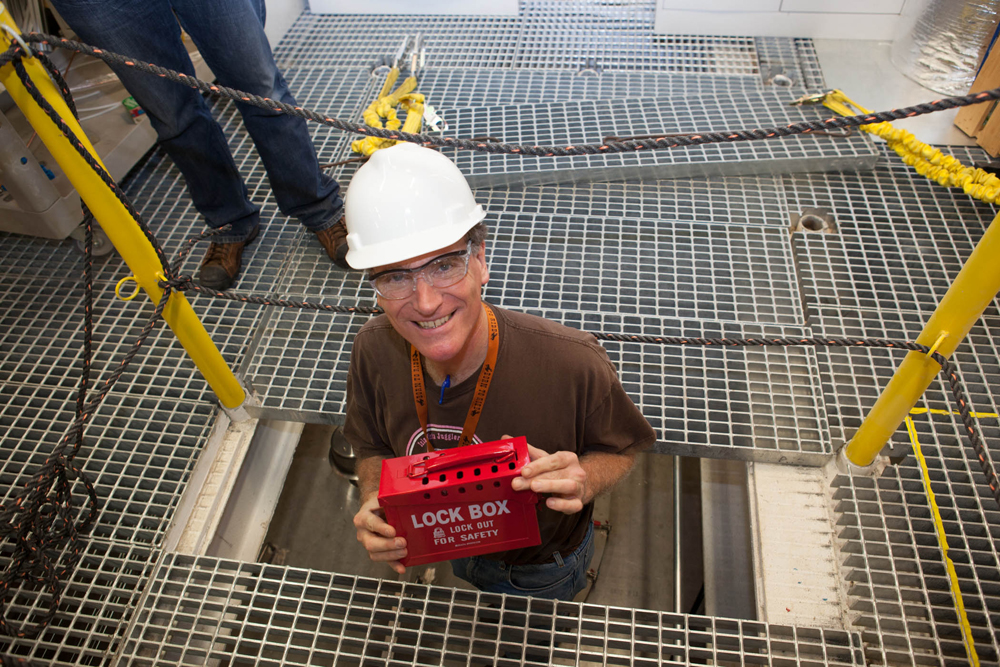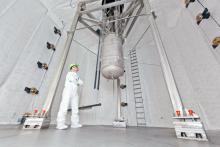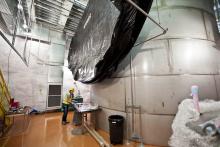
Dark Matter Detector Installed Underground and Submerged; Data Collection to Begin in 2013


An experiment to look for one of nature's most elusive subatomic particles is finally under water, in a stainless steel tank nearly a mile underground, beneath the Black Hills of South Dakota.
The Large Underground Xenon experiment, nicknamed LUX, will be the most sensitive device yet to look for dark matter. Thought to comprise more than 80 percent of the mass of the universe, dark matter has so far eluded direct detection.
"This is a major step forward on the road to an operational detector in early 2013," said Mike Headley, laboratory director for the Sanford Underground Research Facility (Sanford Lab) in Lead, S.D. The Sanford Lab, located in the former Homestake gold mine, is owned and operated by the South Dakota Science and Technology Authority, with support from the Department of Energy, and oversight by DOE's Lawrence Berkeley National Laboratory.
"This is one of our first major milestones," LUX physicist Jeremy Mock said. Mock has worked on the experiment for five years, first as an undergraduate physics student at Case Western Reserve University, and now as a doctoral candidate at the University of California, Davis. Dark matter particles are neutral and they don't emit light, so LUX scientists will look for evidence of collisions between dark matter particles –– called weakly interacting massive particles, or WIMPs –– and atoms of xenon inside the LUX detector.
"Basically, the detector works like a turnstile," Mock said. "It's designed to detect any particle that moves through it, and we're looking for WIMPs."
UC Santa Barbara physicist Harry Nelson –– who helped design, build, and fill the sophisticated water tank that now holds the experiment –– says LUX could help solve a vexing mystery. "The nature of the dark matter is one of the top three open questions in particle physics," Nelson said. "We know that matter like us –– electrons, protons, and neutrons –– makes up only one-sixth of the known matter in the universe. The evidence that the other five-sixths is present out there in galaxies is overwhelming. Detecting dark matter in a laboratory like Sanford, here on Earth, would be a huge step forward in nailing down what the stuff really is."
The LUX scientific collaboration includes dozens of scientists like Nelson and Mock. They come from 17 research universities and national laboratories in the U.S. and Europe.
LUX requires a very quiet environment. In July, the experiment was installed 4,850 feet underground in the Sanford Lab, where it is protected from the cosmic radiation that constantly bombards the surface of the earth. LUX also must be protected from the small amounts of natural radiation from the surrounding rock. That's why the detector, which is about the size of a telephone booth, was lowered into a very large stainless steel tank –– 20 feet tall by 25 feet in diameter. The tank has now been filled with more than 70,000 gallons of ultra-pure de-ionized water that will shield the detector from gamma radiation and stray neutrons.
The water tank also is lined with 20 devices called "photomultiplier tubes," or PMTs, each capable of detecting a single photon of light. Very occasionally, a high-energy particle caused by cosmic radiation will penetrate the earth all the way down to the LUX experiment. If that happens, the resulting tiny flash of light in the water will alert researchers that a corresponding signal in the detector was not caused by dark matter.
Now that LUX is under water, researchers are testing the experiment's complex electronics –– a process that will take weeks. The detector itself is a double-walled titanium cylinder about 6 1/2 feet tall by 3 feet in diameter. The cylinder is a vacuum thermos –– or "cryostat" –– that holds about one-third of a ton of xenon, cooled to a liquid state at minus 160 degrees F. Inside the cryostat, 122 smaller PMTs will detect when a WIMP bumps into a xenon atom. The collision will produce two flashes of light –– one at the point of impact, and a second flash in a thin layer of xenon gas at the top of the detector. The second, stronger flash will be caused by electrons released during the collision and drawn upwards by a strong electrical field inside the detector. Researchers will compare data from the two flashes to determine whether dark matter has been discovered.
Why search for dark matter? Nelson pointed out that practical applications of fundamental research are sometimes not immediately apparent. However, research into the nature of electricity in the 19th century, and into the structure of the atom in the early 20th century, led to technological advances that have become essential to manufacturing, communications, medicine and high-speed computing.
"Unforeseen consequences are one of the most exciting aspects of scientific exploration and discovery," Nelson said.
Today, dark matter's invisibility both "confounds and motivates" researchers, Nelson said, and scientists are looking for it in a number of experiments around the world. "The Sanford Lab provides us with a crucial facility to forge ahead toward the goal of ‘touching' dark matter here on Earth," he said. "The most popular theories in particle physics indicate that success will come soon, either at the Sanford Lab or a little later at labs in Canada, Italy or China."
† Top image: Physicist Harry Nelson of UC Santa Barbara holds the lockbox containing a key that allowed researchers to open the valves to fill the LUX water tank.
†† Middle image: UC Davis physicist Jeremy Mock inspects the LUX detector, the cylinder in the center, inside its protective water tank, which now has been filled with ultra-pure water.
††† Bottom image: Mikayla Thompson of Yale University works near the exterior of the LUX water tank, on the bottom floor of a cavern originally excavated in the mid-1960s for a solar neutrino detector.
Credit for all photos: Matt Kapust/Sanford Lab
Related Links



